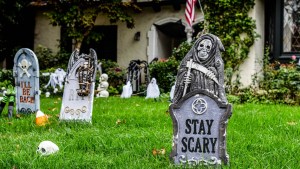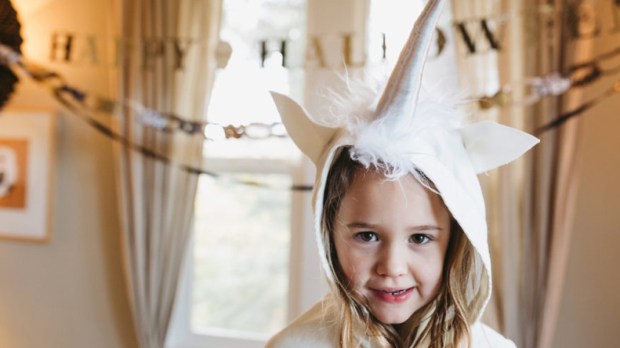As a lifelong lover of Halloween, as someone who unabashedly declares it a “top-3” holiday, I’ve gotten my share of pushback. I’ve heard from folks who wonder, especially, how a such a seemingly nice and normal woman of faith can take such delight in such a dark, “evil” day.
And I understand their concern. Even among those who like Halloween well enough, those of us who take their kids trick-or-treating and happily hand out candy, there’s a sense among many that Halloween celebrations should stay away from the really scary elements.
My own mother forbade scary costumes. Each Halloween, she’d get out her sewing machine, her measuring tape, and lovingly turn me into a panda, a bear, a clown (how this isn’t scary I’m not sure …). But never a vampire, witch, or swamp creature. My mom shared the concern of parents who worry about their kids being exposed to the terrifying, of seeing the blood and the gore, of the haunted houses that pop up in neighborhoods.
And yet, these Halloween doubters are wrong. It’s true: Halloween is dark. It is scary. It does bring our fears to the surface. It does shake us up. But that’s a good thing. Especially for our kids. In fact, in my own life and in my parenting, I’m not sure I’ve experienced any other time of year (well, maybe except Easter and Christmas) that’s as good for talking about our faith or that’s as good for encouraging spirituality.
Here’s why:
Halloween helps us talk about the hard stuff
There’s just something about the turn of seasons, the way days shorten, the leaves fall, and the cold, sharp wind that gets my imagination and creativity going. Add to that the spooky decorations that show up on house, the predominance of jet-black ravens, bats, and cats, the ghost stories that get pulled off bookshelves and get told — even on the normally spritely Disney Channel — and my kids and I end up having the wildest “what if” kinds of conversations. Even when and if these “what if” conversations are about dying leaves or darkening skies or monsters.
Because these are opportunities to talk to our kids about what we do know — that we work hard to keep them safe, that God is near, that we can always pray, that boogiemen aren’t real — and share our own fears of the dark, of loved ones dying, and even of the “monsters” (e.g. frustrating bosses, unkind people) we’ve experienced and how we “fought them.”
Simply telling our kids there’s nothing to be afraid of does them a disservice. Telling them the world is sometimes scary, on the other hand, but that we have tools to fight the scariness, equips them for life — and also tells your kids that you as a parent will shoot straight and tell them the truth when they come asking.
Halloween helps us face fears
We can tell our kids they need to learn to face their fears till we’re blue in the face, but until they have an opportunity to do it, how much can they learn? It’s why we pry them off our legs on their first days of preschool and coax them off diving boards. It’s why we put them on skis and in saddles, on bikes and on roller coasters. It’s even why we play Hide and Go Seek. Fear lies at the core of what thrills us. And we’re thrilled because doing something scary — living through something scary — is a thrill. And a good thrill at that.
So, having a holiday that adds a number of harmless fears to our lives and gives us opportunities to face them and live through them not only gives us a thrill but teaches a life lesson: We’ll always have things that scare us, whether real or imagined. Not every fear is one of physical safety, sometimes it’s fear of unknowns or of our own spiritual questions. And part of being a person of faith and staying spiritually healthy is having the ability to face those fears. Thankfully, like on Halloween, we come out of fear-facing experiences better for having walked through them.
One great way to teach our kids with the ooky-spooky of Halloween (and of the monsters-under-your-bed variety) is to teach them a short prayer or Bible verse to repeat in their mind or out loud.
Consider something like “I don’t have to be scared because God is with me” (from Isaiah 40: 10) or The Guardian Angel Prayer.
Halloween helps us embrace the mysteries of our faith
Let’s face it: Part of why kids (and adults like me) love Halloween is because it’s creepy and mysterious. For whatever reason, those things just draw us.
While some people find this a sign of evil within, I disagree. For me, I’m drawn to the creepy and mysterious elements of Halloween for the same reasons I’m (bear with me!) drawn to the creepy and mysterious elements of our faith.
And there are a lot of creepy and mysterious elements of our faith. Whether we’re talking about lives of the saints or reading Bible stories, we run into frightening moments more often than we’d often like. Same when we’re in church. Not only do we pray to the Father, Son, and Holy Ghost, but we worship in sight of a crucifix and the stations of the cross and partake in the holy sacrament — all of which can seem terrifying to a child (we’re eating and drinking what?!?!). Our very faith hinges on a belief that a man died and rose from the dead! The ultimate “mystery of our faith” is creepy — and yet, so compelling. Just like every other element. These “creepy” bits of our faith aren’t about scaring us for scary’s sake, but about coaxing us to wonder and discover.
But sometimes those questions are harder to ask. Especially for kids. They don’t always have the words or might feel afraid of seeming “heretical.” Halloween gives us words and context to talk about mysteries and monsters and what’s good and bad about creepy. It brings us up close and personal with gore that can open up lines of communication that kids might not feel otherwise comfortable asking about Jesus or the saints.
Halloween can be a great time to remind our kids that not everything that spooks them or worries them or confuses them is bad. Sometimes those are the best things, as they can spark ideas and curiosity and questions that ultimately can lead back to God.

Read more:
Has Halloween horror morphed from innocent fun to a troubling symptom?

Read more:
A classical music playlist for Halloween

